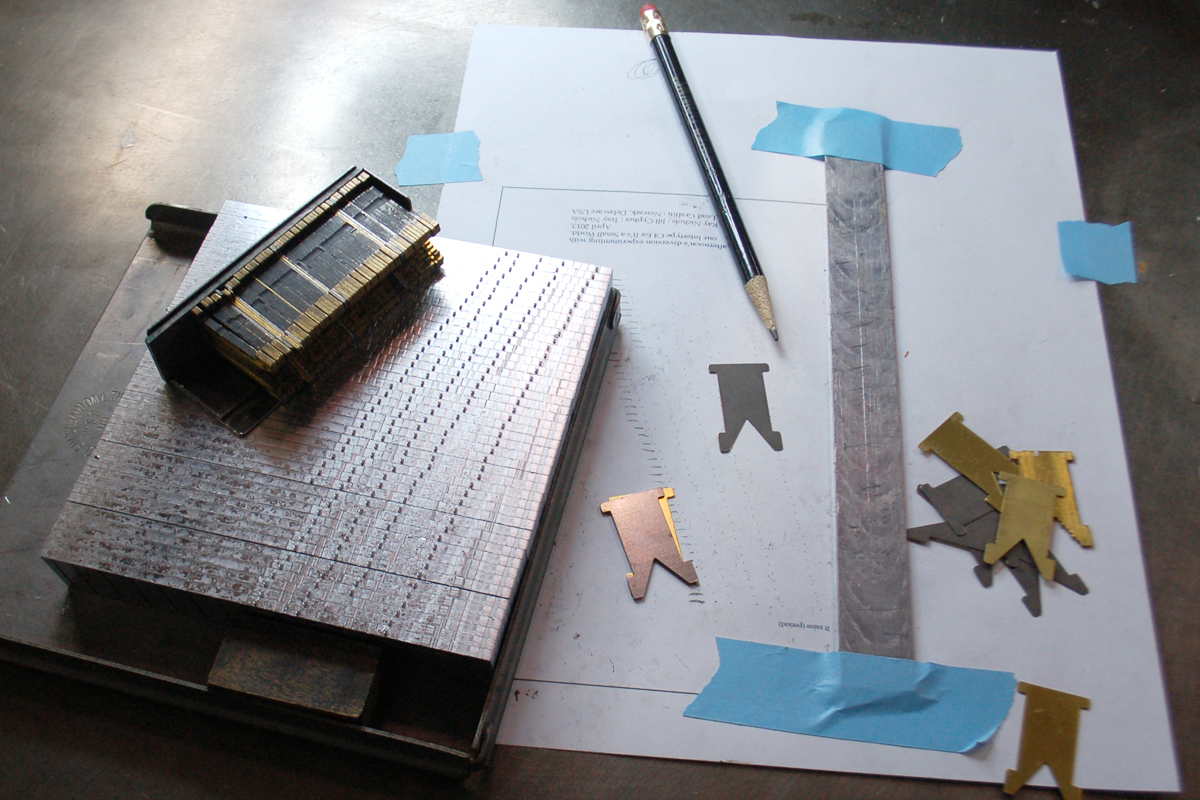⬆ IT’S A SMALL WORLD is a 5” x 7”, collaborative book that has been produced annually since 1952. Lead Graffiti has produced pages off and on since 2012. The image above is our favorite page which is project #2 below.
Project #1 : Just our type of rain
THE IMAGE ABOVE SHOWS LEAD GRAFFITI’S FIRST DIVE into the project. We had recently discovered that our Intertype C4 had a lever we could switch to cast multiple copies of the same line of hot-metal type. We’re always looking for a way to use type that isn’t just casting lines of prose. It didn’t take long to realize that if we set a line using the word “Rain” using upper and lowercase letters with a few interspersed periods as raindrops, we could create repeating lines of typographic weather. Repeating a few at the bottom to mimic splashing gave us a solution we didn’t mind spreading across the world.
It’s a Small World is a publication produced mainly by hobbyist printers with some serious printers mixed in. Given our creative interests, the publication offered us a chance to do some high-end experimentation.
Project #2 : Graphic poetry. Period.
Ray has long been haunted by an image of a graphic poem, entitled “Il Pleut” (It Rains), by Guillaume Apollinaire (1880–1918), a French poet, playwright, short story writer, novelist, and art critic of Polish-Belarusian descent. The simplicity of the poem, the use of a typewriter as a production tool, and the clear avoidance of trying to not look handmade, presses all of the right buttons.
We had just gone through boxes of miscellaneous Intertype parts, many of which totally escaped some sense of use. A box of spacing material came to light. On the keyboard of the Intertype, there is only room for 3 different widths of spacing—thick, middle, thin. This new box of spacing gave us a dozen different widths, including very, very thin. This gave us the opportunity to space characters fairly carefully. Not as finely as a computer, but it offered more options at least.
Ray scanned the text of “Il Pleut” (shown below) and replaced each letter with a map of carefully positioned periods to replicate the feel of the original poem.
The image above shows the 5 brass matrices for the periods on each line spread apart by various options of spacing. Each line was painstakingly accurate to the printout of the poem. Overall it took about 5.5 hours to completely set our “period” version of the poem, carefully adding increments of 1/2 point (144th of an inch) until everything aligned. The image below shows the cast lines, each with 5 periods, and a variety of the spacing matrices we had to work with.
This project is probably the most complicated and Ray’s favorite using the Intertype.
Project #3 : Rain’s forecast again?
Rain Poem No. 3 allowed us to experiment with our Intertype as a tool for creating 1 point rules and merging them with periods to interpret rain visually in yet one more way. We’ll see what 2019 brings into play, though we may start down a different path with this year’s submission.
We’ve been trying to collect a full set of the now 65 issues of It’s a Small World and are down to 4 that we lack. The problem is that issue number 1 is scarce, rarely available and one of the missing copies we’re seeking. We are hoping to find someone who would give us a set of scans of the pages so we could at least fill the hole with a facsimile.
You can click here to read about the history of It’s a Small World by Alan Brignull.










